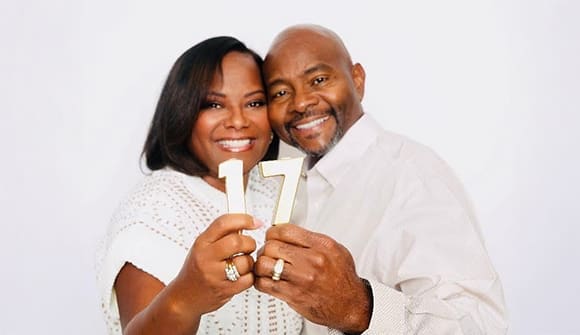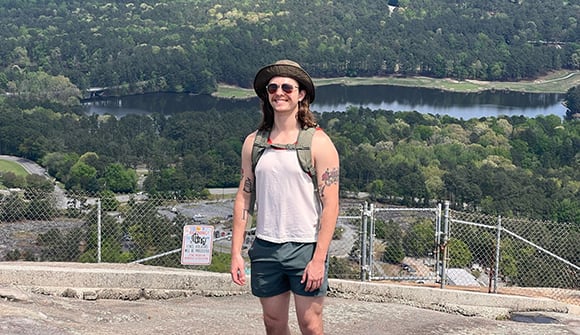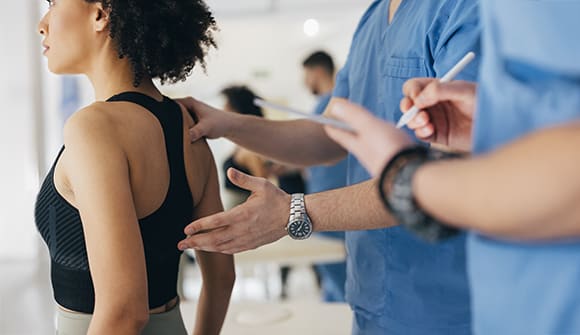Aneurysm patient back on cruise control
Using new technology, surgeons removed two giant aneurysms and sent Rhonda Baker back out on the dance floor.
Article Date:

On a cruise ship headed to the Dominican Republic, Rhonda Baker danced up a storm with her three sisters, son and extended family.
Wherever there was music, she was there.
After all, Baker has a lot to celebrate. Not so long ago, she wasn’t even sure she’d live long enough to join the weeklong cruise she and her family have taken to various countries over the past 20 years.
In the fall of 2015, doctors discovered two giant aneurysms, a whopping 33 millimeters and 26 millimeters in size, compressing her left optic nerve. Vision problems in her left eye led to scans that revealed the aneurysms—weak or thin spots on blood vessels in the brain that balloon and fill with blood.
“I knew two people who suffered from ruptured brain aneurysms and saw how they struggled after the aneurysms burst. They had difficulty getting back to living normal lives,” said Baker, 58.
The vivacious assistant retail manager, who loves meeting new people and lives by the motto that “nobody is a stranger,” was determined not to suffer a similar fate. She had too much dancing and cruising left in her.
Baker’s primary care doctor referred her to Ricardo Hanel, MD, PhD, neurovascular surgeon with Lyerly Neurosurgery and director of the Baptist Neurological Institute at Baptist Medical Center Jacksonville.
Dr. Hanel treated her brain aneurysms in October 2015 using an FDA-approved, innovative, minimally invasive technology called the Pipeline™ Flex embolization device, specifically designed for large or giant, "wide-necked" unruptured brain aneurysms.
Delivered through her groin up to her brain, the device implants a braided cylindrical mesh tube across the neck of the aneurysm. It redirects blood flow away from the aneurysm and provides a scaffold to reconstruct and heal the vessel.
"The Pipeline device is simply a breakthrough in neurovascular surgery in how we treat patients with unruptured brain aneurysms," said Dr. Hanel. "The ability to address large and giant, wide-necked aneurysms with minimally invasive methods is a valuable advancement in how we treat aneurysms today.
“Several years ago, it wouldn’t have been imaginable to treat complex brain cases such as Rhonda’s without open brain surgery and with such successful results.”
The Brain Aneurysm Foundation estimates that 6 million people in the United States suffer from unruptured brain aneurysms—that’s one in every 50 people. A brain aneurysm ruptures every 18 minutes and ruptured aneurysms are fatal in about 40 percent of cases.
A follow-up procedure in September to treat a smaller aneurysm on the right side of her brain showed that both of Baker’s giant aneurysms have completely healed.
That was music to Baker’s ears. Not only did it mean she’d make her October cruise, but she could go back to living life with fewer worries. And living she does, whether line dancing with her sister or cooking her comfort soul foods—ribs, collard greens and turkey wings.
She’s now making sure everyone she meets hears two messages: Listen to your body, and live life to the fullest.
“If something doesn’t feel right, don’t ignore it. Get it checked and see a health care professional,” Baker said.
Since the aneurysm damaged her optic nerve, she still can’t see well out of her left eye. But being alive is all that matters, she said.
“I’m blessed to be alive,” Baker said. “You only live once and tomorrow is not promised. You go and have a good time because I’m going to have a good time. You may not wake up in the morning so go ahead and do what you do—live.”



